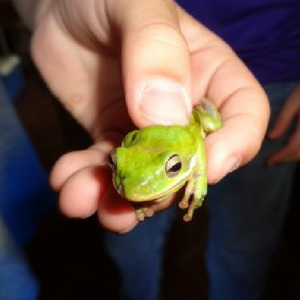Amphibians across Oklahoma are coming down with an infectious — and often fatal — disease that impairs eating and sustaining respiration through their skin.
The disease (chytridiomycosis, or chytrid for short) is caused by the pathogen Batrachochytrium dendrobatis (Bd), which creeps into ponds, lakes and streams and is passed from animal to animal. It’s even spread from one body of water to the next by humans on their untreated fishing and boating equipment.
For now, scientists are unsure just how widespread the fungal disease is throughout Oklahoma.
All that might sound pretty bleak, but the Sam Noble Museum’s herpetology staff has dozens of allies throughout the state who are eager to help them get a more accurate understanding of the problem. Tasked with testing amphibians from all of Oklahoma’s 77 counties, the museum enlisted citizen scientists, or students in elementary through high school, to find, catch and swab amphibians for their cause.
“We couldn’t get to every county ourselves — it’s just impossible,” said Jessa Watters, collection manager for the herpetology department. “The Amphibian Infectious Disease Citizen Science Project gives us a lot more data, and it provides classrooms around the state a really great outdoor education activity that maybe they would never get to do.”
The Herpetology Department has recently been awarded a three-year grant from the Oklahoma Department of Wildlife Conservation and a one-year grant from Oklahoma City Zoo’s Conservation Action Now program to test amphibians in 23 counties around the state. What they have found so far surprised them.
“What we had discovered after one year of testing on our own is that the chytrid fungus is much more widespread in Oklahoma than we would have guessed,” Watters said. “Almost no one had been checking this before. We’ve seen counties with 30 to 100 percent infection rates.”
When teacher Diana Cook heard about the Amphibian Infectious Disease Citizen Science Project, she knew it was a perfect fit for her seventh-grade class at Collinsville Middle School. It wasn’t difficult to get her whole class on board, and soon enough, they were catching and swabbing frogs at a creek close to their school.
“The students were very interested in the fact that what we were doing wasn’t just a class project; it was actually going to be put into a database and the samples we took and sent back to the museum would be researched with other samples in Oklahoma,” Cook said.
“They were definitely very curious about the disease, why we were worried about it and what we could do. And the project fit into our lesson while we were studying ecology. We talked about what would happen if frogs disappeared and the fact every single thing is dependent upon everything.”
Cook’s class and others participating around the state received museum-prepared kits containing 10 pre-sterile, individually packaged cotton swabs; 10 pre-sterile, 1.5mL screw-top vials; instructions; datasheets; a permanent marker; and an Oklahoma frog identification guide.
In addition to requesting the kits, teachers downloaded the complete Citizen Science teacher packet that contained a lesson plan, sampling instructions, datasheets, student worksheets and background information.
Citizen scientists needed to follow several steps to accurately identify the frogs and the frogs’ location. Once they caught a frog, they swabbed it and placed the swabs in the provided vials to send back to the museum. The museum then extracts DNA from the swabs before sending them to a third party to test for the disease. The herpetology staff currently awaits results for this year’s project.
So, what can Average Joes do now that they know about the chytrid disease? It’s simple, Watters said. Eliminate your chances of spreading the disease by cleaning gear taken from one body of water to another, especially felt-bottom waders that can house living organisms for weeks.
“Clean everything between trips with bleach or serious amounts of sunshine and drying,” Watters said. “And it’s not just these frog diseases that we should worry about. There’s a lot of aquatic invasive species that are spreading throughout the U.S. — like zebra mussels in the Northeast — and anytime you’re bleaching your gear, it will stop that kind of spread.”
Watters hopes the pilot project can continue with new classes each year and transform more students into citizen scientists. Cook is one teacher who hopes to incorporate the project into her upcoming classes.
“I wanted my students to get excited about science,” she said. “They got excited about some of the little projects we did, but nothing really major. And this was big for them. They felt like they were part of something, even at their age. They felt like scientists.”
Find more information about the project and up-to-date results at cameronsiler.com/citizen-science.



